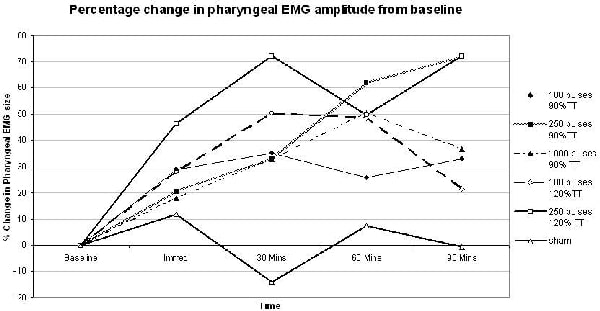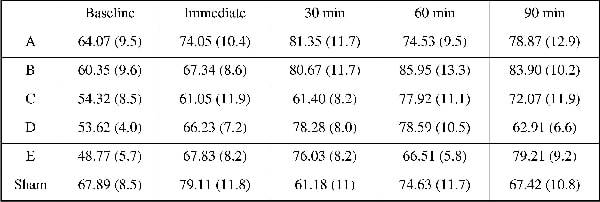Transcranial magnetic stimulation (TMS) has been used to demonstrate that recovery from stroke is associated with increased size and excitability of the swallowing motor cortex [1]. In healthy volunteers the optimal frequency of repetitive TMS (rTMS) to induce excitation in swallowing motor cortex is 5Hz [2]. However, little is known about the dose effects of intensity or duration of rTMS in this region. The aim of our study was to assess differing doses of rTMS prior to studies on dysphagic stroke patients. Twelve healthy subjects took part. EMG responses were recorded using a pharyngeal catheter with ring electrodes. Thenar responses were recorded to determine the thenar motor threshold (TT). Twenty EMG responses to single pulse TMS over one hemisphere were recorded and averaged before and up to 90 min following a range of doses of rTMS. Subjects underwent 6 interventions on separate days, given in a randomised order and double blinded: A (100 pulses at 90% TT); B (250 pulses at 90% TT); C (1000 pulses at 90% TT); D (100 pulses at 120% TT); E (250 pulses at 120% TT); and sham stimulation(250 pulses at 120%TT, with coil tilt). Thenar threshold was chosen to comply with rTMS safety guidelines. EMG amplitude was normalised to baseline for each individual. Statistical comparisons were performed using repeated measures ANOVA. All interventions showed an increase in cortical excitability compared to sham, which varied no more than 14% from baseline. The ANOVA revealed a significant effect of time (F(3.7,110)=5.3, p<0.001), indicating a strong effect of rTMS, and a significant treatment vs time interaction (F(3.7,110)=3.3;p=0.016), showing excitability differences between the interventions (Fig. 1, Table 1). To probe this further, an area under the curve analysis using paired t tests comparing each intervention with sham showed a significant difference with B (p=0.006), C (p=0.004), D (p=0.001) and E (p=0.007). Differing doses of rTMS seem able to induce significant increases in pharyngeal cortical excitability. Our data suggest that while increasing the intensity and duration of stimulation may lead to larger increases in excitability, there is no additional benefit gained by giving more than 250 pulses of stimulation. We propose that 250 pulses given at 120% of thenar threshold may be the optimal regimen for inducing excitability in swallowing motor cortex.
University College London 2006 (2006) Proc Physiol Soc 3, C74
Oral Communications: Dose-dependent effects of rTMS on human pharyngeal motor cortical excitability
Samantha Jefferson1, Salil Singh1, Satish Mistry1, John Rothwell2, Shaheen Hamdy1
1. Department of GI Science, Hope Hospital, University of Manchester, Manchester, United Kingdom. 2. Sobell Department of Motor Neuroscience and Movement Disorders, Institute of Neurology, University College London, London, United Kingdom.
View other abstracts by:
Figure 1. Change in pharyngeal EMG amplitude over time in response to each of the active interventions and sham.
Table 1. Pharyngeal EMG amplitude µV (standard error).
Where applicable, experiments conform with Society ethical requirements.


